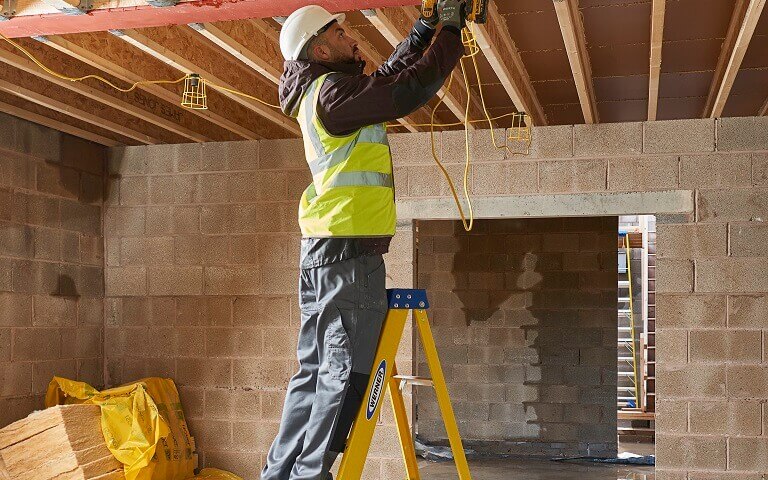When working with or near electricity it is important to consider your safety with the ladder you’re using to avoid a bad accident. There are a lot of different types of ladders on the market today in a range of materials but when working around electricity it is vital to avoid metal ladders. You likely already know this, but you should be choosing a non-conductive material of ladder such as wood or fibreglass. If you haven’t worked with electricity before then this guidance on ladder safety will hopefully be useful to you so let’s get started.
1) The basics of ladder safety
Before climbing any ladder but particularly important when working with electricity there are a few safety measures you should check. These include level and secure footing, securing the ladder and locking safety arms, and be aware of any overhead obstacles and clear any debris above or around the ladder base below to make for a safe work area. For electrical work, step ladders are often used for both inside and outside connections.
2) Know the climbing limits
Stability is key in ladder safety especially in a more dangerous situation, you should never climb on the top or second to top step on a ladder. This will affect your balance and add more risk but you should also be careful of standing too low on the ladder and putting yourself in a position where you have to stretch up to complete work.
It is advisable to get a taller ladder to complete the task and always play it safe. Electrical work can often involve power tools, which increases the level of danger because if a drill bit sticks for instance and moves you around you could fall off if not correctly positioned.
3) Solid and level ground for the ladder base
Carrying out work with electricity could sometimes mean you’re in more difficult or awkward areas for ladder placement. Try and find a level working surface for your ladder but if you must use dirt or gravel to level the surface ensure it is fully compacted and solid. On some occasions you may require blocking material to level the ladder base. In this situation choose flat, solid boards or timbering as they can’t easily slide from the bottom of the ladder base.
4) Look around for hidden dangers
It is important to be extra aware of overhead dangers when climbing a ladder such as bare wires or obstacles that you could bump your head on. Sometimes there could be electrical lines like overhead service lines in the area you are working in so keep that in mind before you climb. As well as this there could be pipes or other objects sticking out the ground that you could trip over or fall onto if you come off the ladder. If it is possible, move these hazards out of the way before starting your work.
5) Choose the right ladder
As previously mentioned, wood and fibreglass are both non-conductive which makes them suitable choices for electrical work. When deciding between these materials you should consider the benefits and drawbacks of them. For example, wood is non-conductive but isn’t ideal for outdoor conditions over a long period of time because they can rot over time when wet from the rain. Whereas fibreglass will withstand outdoor weather for a long time, but it is more expensive than wood. It is up to you to decide what will suit your needs best.
So, that’s our look at safety tips for electrical work. We hope you have found something helpful in there. Explore our website to see the range of ladders we offer for a range of tasks from home DIY to construction work. Get in touch with our team if you have any further questions or queries.
No related posts.



